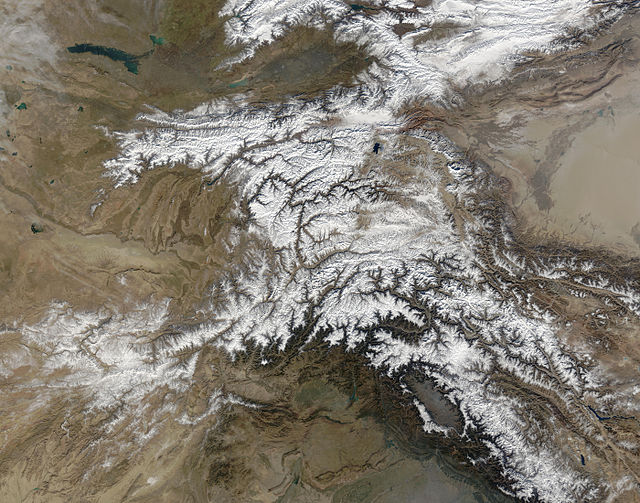Loading AI tools
River in Afghanistan and Tajikistan From Wikipedia, the free encyclopedia
The Panj (UK: /ˈpændʒ/ PANJ, US: /ˈpɑːndʒ/ PAHNJ),[a] traditionally known as the Ochus River, is a river in Afghanistan and Tajikistan and is a tributary of the Amu Darya. The river is 921 kilometres (572 mi) long and has a basin area of 114,000 square kilometres (44,000 sq mi).[2] It forms a considerable part of the Afghanistan–Tajikistan border.[3]
| Panj | |
|---|---|
 The Panj river forms much of the border between Tajikistan and Afghanistan | |
 | |
| Location | |
| Countries | Afghanistan and Tajikistan |
| Physical characteristics | |
| Source | |
| • location | confluence of Pamir and Wakhan Rivers |
| Mouth | Amu Darya |
• coordinates | 37°06′39″N 68°18′53″E |
| Length | 921 km (572 mi) |
| Basin size | 114,000 km2 (44,016 sq mi) |
| Discharge | |
| • average | 1,000 m3/s (35,315 cu ft/s) |
| Basin features | |
| Progression | Amu Darya→ Aral Sea |
| Official name | Lower part of Pyandj River |
| Designated | 18 July 2001 |
| Reference no. | 1084[1] |
 | |

The river is formed by the confluence of the Pamir River and the Wakhan River near the village of Qalʿa-ye Panja (Qalʽeh-ye Panjeh). From there, it flows westwards, marking part of the border of Afghanistan and Tajikistan. After passing the city of Khorugh, capital of the Gorno-Badakhshan Autonomous Region of Tajikistan it receives water from one of its main tributaries, the Bartang River. It then turns towards the southwest, before joining the river Vakhsh and forming the greatest river of Central Asia, the Amu Darya. The Panj played an important role during Soviet times, and was a strategic river during the Soviet military operations in Afghanistan in the 1980s.


A water treaty between the Soviet Union and Afghanistan, signed in 1946, allows Afghanistan to draw 9 million cubic metres of water a year from the Panj.[3] It currently draws 2 million cubic metres of water. According to the Panj River Basin Project, environmental damage could be expected if Afghanistan drew the entire amount of water from the river that the treaty allows.
The Aga Khan Development Network has been engaged in a project to build a series of three bridges across the Panj River between Tajikistan and Afghanistan.[5]
Seamless Wikipedia browsing. On steroids.
Every time you click a link to Wikipedia, Wiktionary or Wikiquote in your browser's search results, it will show the modern Wikiwand interface.
Wikiwand extension is a five stars, simple, with minimum permission required to keep your browsing private, safe and transparent.